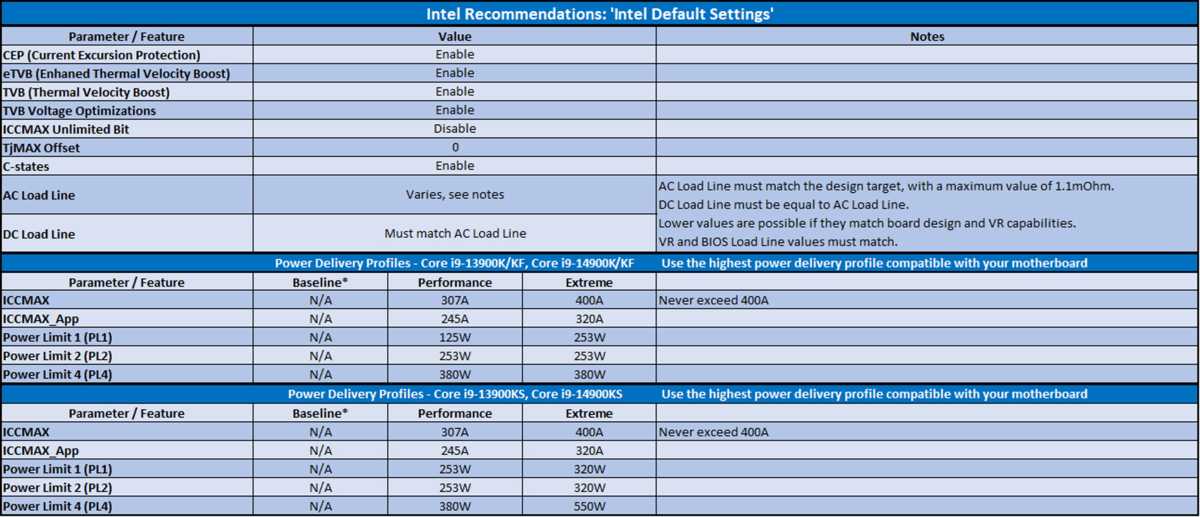Intel isn't recommending baseline power profiles to fix crashing CPUs
 Image: Intel
Image: IntelIntel has denied a report saying that it’s asking its motherboard partners to implement lower, “baseline” power profiles to solve instability issues and potentially nerf performance in its 13th- and 14th-gen Core processors..
Instead, it’s the opposite: “Intel is not recommending motherboard manufacturers to use ‘baseline’ power delivery settings on boards capable of higher values,” an Intel spokesman said in an email. But the company is asking motherboard vendors to include a new Intel Default Settings BIOS option tuned for stability, which we’re already seeing roll out in the while — it’s just different from the “baseline” power profiles initially rushed out. The details matter.
This article was first published on May 9, but has been updated to mention MSI’s new Intel Default Settings BIOS below.
Many reports have bubbled up that Intel’s 13th- and 14th-generation Core chips have suffered from instability, with users experiencing crashes and Blue Screens of Death (BSODs) when playing games. Intel hasn’t said how many processors have been affected or under what conditions the instability may occur, although a leaked memo appears to blame motherboard manufacturers and their choice of turning off of safety features. That same memo indicates Intel plans a more consumer-focused statement in May.
PCWorld asked for an explanation of what was going on in response to reports that Intel was supposedly going to enforce more stringent restrictions on turbo (PL2) clock speeds, which would effectively rob them of performance. Motherboard makers were reportedly being told that Intel would enforce “baseline” settings. As PC Gamer noted, Asus was one of the motherboard manufacturers to release an updated BIOS with an “Intel Baseline Profile” — but discovered that the power limits that Asus was enforcing went way over those stock or “baseline” speeds.
Adding to the confusion and hand-wringing was Gigabyte’s implementation of a baseline profile that differed from others that drastically lowered the performance of the CPUs by as much as 30 percent and also appeared to use excessive voltage as well. Gigabyte had touted the new Intel baseline profile in a press release–but has appeared to have pulled it now.
Intel is refusing to set “baseline” profiles
It’s unclear whether Intel’s statement is designed to indirectly address how Asus implemented the “baseline” profile, or if they simply don’t apply to Intel’s Core i9-13900K/KF and Core i9-14900K/KF processors instead. But Intel said a “baseline” profile doesn’t apply to its fastest chips.
“Several motherboard manufacturers have released BIOS profiles labeled ‘Intel Baseline Profile’,” Intel said in a statement. “However, these BIOS profiles are not the same as the ‘Intel Default Settings’ recommendations that Intel has recently shared with its partners regarding the instability issues reported on 13th and 14th gen K SKU processors.
“These ‘Intel Baseline Profile’ BIOS settings appear to be based on power delivery guidance previously provided by Intel to manufacturers describing the various power delivery options for 13th and 14th Generation K SKU processors based on motherboard capabilities,” Intel added. “Intel is not recommending motherboard manufacturers to use ‘baseline’ power delivery settings on boards capable of higher values.”
Put another way, Intel said that “baseline” power delivery profiles aren’t recommended for its 13th- and 14th-gen K-series processors.
Intel is restricting PL2 values on the Core i9-13900K/KF and the Core i9-14900K/KF to 253W on both the “Performance” and “Extreme” profiles, Intel said. On the Core i9-13900KS and Core i9-14900KS, PL2 levels are set at 253W for the “Performance” and 320W for the “Extreme” Profile. Intel is also placing limits on ICCMAX power, “never” exceeding 400A at most.
“Intel’s recommended ‘Intel Default Settings’ are a combination of thermal and power delivery features along with a selection of possible power delivery profiles based on motherboard capabilities,” Intel goes on. “Intel recommends customers to implement the highest power delivery profile compatible with each individual motherboard design as noted in the table below.”

IDG via Intel
IDG via Intel
IDG via Intel
Intel doesn’t seem to be specifying which implementations must use the Performance profile, and which use the Extreme profile. But it at least is an indication that Intel is working toward a solution. Falcon Northwest has also published a workaround, which it characterized as a “work in progress.”
Update: Just two days after Intel issued this statement to press, MSI has already issued new motherboard BIOS containing Intel Default Settings as the default option, along with new Power Limit settings tied to whether you use an air tower cooler or a liquid cooler.
We’ve asked Intel if they understand the scope of the problem, and how (or if) RMA or warranty returns will be affected, and whether the company has seen instability on the Performance and Extreme settings. We’ll update this story if and when we learn more.
Author: Mark Hachman, Senior Editor

As PCWorld’s senior editor, Mark focuses on Microsoft news and chip technology, among other beats. He has formerly written for PCMag, BYTE, Slashdot, eWEEK, and ReadWrite.
Recent stories by Mark Hachman:
AMD gains big in desktop CPUs versus Intel in first quarter 2024Apple claims its M4 chip’s AI will obliterate PCs. Nah, not reallyIntel says manufacturing problems are hindering hot Core Ultra sales




